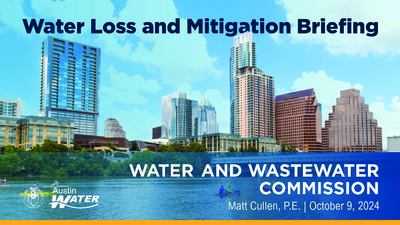Item 10 Water Loss AW Presentation — original pdf
Backup

Agenda 1. AW’s Practices and Current Metrics 2. AW’s Implementation Plan for Water Loss Program Review, Analysis, and Optimization report recommendations 3. Summary and Questions Water Loss and Mitigation Briefing Overview: Austin Water’s water distribution system includes 4,015 miles of pipeline ranging in size from 2-inch diameter to 84-inch diameter pipes. While all water systems experience water loss, Austin Water has a multi- pronged approach to reduce sources of water loss in our system and to increase the accuracy of our metrics. On-going participation in industry best practices and innovations Fast response to reported leaks Infrastructure renewal investments Proactive detection and prevention Austin Water’s Performance Water Loss Trend TWDB SUGGESTED RANGE: 3-5 10 9 8 7 6 5 4 3 2 1 FY 08 FY 09 FY 10 FY 11 FY 12 2015 Infrastructure Leakage Index (ILI) FY13 2014 2016 2017 2018 Water Forward 2018 Goals 2019 2020 2021 2022 2023 ILI is within Texas Water Development Board’s suggested range AW’s EUM Water Loss Team Lead pipe Water Loss Review, Analysis & Optimization Report Implement programmatic improvements to proactive leak detection activities Expand program currently underway to replace poor performing water service lines Improve production meter accuracy at the water treatment plants Strengthen data validation practices for large meters Expand data management and analysis tools across the water loss program Improve estimates of unbilled authorized consumption (e.g., water for flushing and fire fighting) Implement training for utility staff on reducing water loss during normal operations Evaluate creating district metering areas (DMAs) to pilot reducing water loss through pressure management Lead pipe Leak Detection Practices Continue to cover our entire system approximately every 6 years Continue large diameter leak detection and condition assessment program Assemble a leak detection SOP that will include: • Contract standards • Data management • Ongoing staff training • Piloting of new technologies • Conducting baseline leak detection validation • Inspecting ARV’s, valves & vaults on transmission mains System Renewal – Overview Understanding Your Water Service Line System Renewal – Water Mains Main Break History INDUSTRY AVERAGE OPTIMIZED UTILITY 30 25 20 15 10 5 0 Continue investment in renewing poor performing infrastructure to keep main leaks low 2011 2012 2013 2014 2015 2016 2017 2018 2019 2020 2021 2022 2023 AW Breaks/100 miles Industry Avg Breaks/100 Miles Optimized Utility Breaks/100 Miles System Renewal – Service Lines Service Line Break History INDUSTRY AVERAGE 7 6 5 4 3 2 1 0 Continue investment in renewing poor performing infrastructure to increase focus on service lines 2011 2012 2013 2014 2015 2016 2017 2018 2019 2020 2021 2022 2023 AW Breaks/1000 Services Industry Avg Breaks/1000 Services Production Meter Measurement Improvements Lead pipe Assemble SOP to strengthen our O&M, calibration, and data handling processes related to production meters Institute regular use of secondary meters for validation purposes Study production meter configuration and performance to identify needed capital improvements and execute those improvements. Apparent Loss Tracking Lead pipe Document apparent loss control processes in an SOP that will include: • Enhancement of large customer meter testing • Meter testing program validation • Proper meter sizing • Meter replacement Refining Water Loss Tracking and Reporting Continue to be active in the water loss industry by attending national water loss conferences and participating in industry water loss committees Maintain high data validity scores Assemble SOPs on unauthorized consumption mitigation and data handling errors mitigation Evaluate process of transferring data from the billing system to water loss tracking Refine system flushing and firefighting volume estimates Expand training for annual water audit and validation Improve Estimates of Unbilled Authorized Consumption Refine flushing volume estimates Refine firefighting volume estimates Lead pipe Implement Training for Utility Staff Train leak detection staff on an annual basis Train additional staff for water auditing and validation Continue to participate in national water loss conferences and committees Evaluate Creating District Metering Areas (DMAs) Pilot District Metered Areas (DMAs) and potentially create permanent DMA’s/Pressure Management Areas (PMA) • Austin Water has piloted two DMA’s and is in the process of implementing them within the AMI system. • They are expected to go live prior to the end of the year. Next Steps AW’s Water Loss team will utilize the Effective Utility Management framework to implement recommendations from the report • Identify improvements that can be quickly implemented • Begin the process of implementing long-term recommendations • Provide regular reports to stakeholders